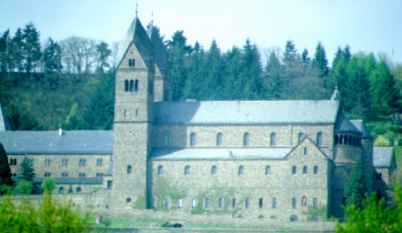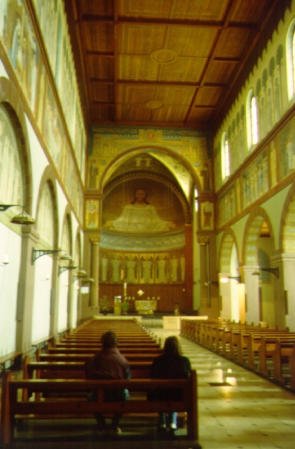The Abbey church of St. Hildegard
 The huge abbey church was built from 1900 - 1908 in the Romanesque style of the ancient basilicas. The nun's choir, where the Benedictines of the Eibingen community assemble seven times a day for their common prayer, adjoins the Sanctuary at its left side. Entering the church, the visitor finds himself in an atmosphere of quiet peace inviting him to contemplation. The clear lines of the high, harmonious room and the subdued somehow mysterious colours of the mural paintings cast a spell on the visitor. The church is entirely decorated in the "Beuronian style"; this work took the time of several years (1 907 - 1913) and was conducted by the Beuron monk P. Paulus Krebs (1849 - 1935), a scholar of the famous painting monk P. Desiderius Lenz (1832 - 1928). The convent church of Eibingen is considered one of the most effective compositions of the Beuron school of art, even though the original form was not fully preserved, since the paintings in the nuns' choir and on the opposite southern choir wall were white-washed in the 1960ies. The Beuronian style of art is a liturgical one and thus a Benedictine art. It serves the glorification of God, inviting to contemplate the divine mystery.
The huge abbey church was built from 1900 - 1908 in the Romanesque style of the ancient basilicas. The nun's choir, where the Benedictines of the Eibingen community assemble seven times a day for their common prayer, adjoins the Sanctuary at its left side. Entering the church, the visitor finds himself in an atmosphere of quiet peace inviting him to contemplation. The clear lines of the high, harmonious room and the subdued somehow mysterious colours of the mural paintings cast a spell on the visitor. The church is entirely decorated in the "Beuronian style"; this work took the time of several years (1 907 - 1913) and was conducted by the Beuron monk P. Paulus Krebs (1849 - 1935), a scholar of the famous painting monk P. Desiderius Lenz (1832 - 1928). The convent church of Eibingen is considered one of the most effective compositions of the Beuron school of art, even though the original form was not fully preserved, since the paintings in the nuns' choir and on the opposite southern choir wall were white-washed in the 1960ies. The Beuronian style of art is a liturgical one and thus a Benedictine art. It serves the glorification of God, inviting to contemplate the divine mystery.
 The interior of the church is dominated by the monumental figure of Christ in the apse. The painting on golden ground reminds the observer of a Byzantine mosaic. Christ appears as the Pantocrator, the king and ruler over the universe, and at the same time as a brother receiving every human being with open arms. The choir arch is crowned by the picture of the City of God and the walls of the Heavenly Jerusalem. The inscription points to the basic theme of the entire church decoration: "Tabernaculum Dei cum hominibus - the home of God among men" On the two sides of the choir arch, St. Benedict and his sister St. Scholastica as founders of the Benedictine order are shown.
The interior of the church is dominated by the monumental figure of Christ in the apse. The painting on golden ground reminds the observer of a Byzantine mosaic. Christ appears as the Pantocrator, the king and ruler over the universe, and at the same time as a brother receiving every human being with open arms. The choir arch is crowned by the picture of the City of God and the walls of the Heavenly Jerusalem. The inscription points to the basic theme of the entire church decoration: "Tabernaculum Dei cum hominibus - the home of God among men" On the two sides of the choir arch, St. Benedict and his sister St. Scholastica as founders of the Benedictine order are shown.
The southern (right) side wall portrays in five areas of arches scenes of the Old Testament: Noah's Ark; the visit of God, i.e. of the three angels at Abraham's and Sarah's home; Jakob's dream of the ladder to Heaven; the procession of priests with the Ark of the Covenant; the altar dedicated to the "ignoto Deo", the "unknown God" ' The northern (left) side wall shows on the middle arch frieze five scenes - except for the first one: Adam and Eve in Paradise - of the New Testament: the incarnation of Christ; the Last Supper, the effusion of the Holy Spirit; the communion between Christ and His Church.
The paintings on the lower arch areas of the northern (left) side wall of the nave are dedicated to St. Hildegard of Bingen. The five-part-cycle shows important scenes from Hildegard's life: Young Hildegard coming to Jutta on the Disibodenberg; Hildegard moving to the Rupertsberg near Bingen; Hildegard talking to the Emperor Barbarossa in lngelheim; Hildegard founding her Eibingen convent and healing a blind boy in Rüdesheim; signs showing up in the sky at Hildegard's death. The paintings of the aisle are dedicated to Hildegard of Bingen as well as to other important women Saints of the Benedictine order. On the eastern wall, above the sacristy door, Hildegard herself is portrayed, a quill in her right hand. All portrays of the Saints are not painted realistically - the artists were not interested in historical painting - but they bear symbolic character and are expression of faith.
The abbey church of St. Hildegard is destination of many pilgrim groups and visitors travelling each year on the paths of the great Saint and finding their way to Eibingen. Everyone who is coming is invited to join in God's praise together with the sisters.
Sr. Philippa Rath OSB
Historical Sites
 The huge abbey church was built from 1900 - 1908 in the Romanesque style of the ancient basilicas. The nun's choir, where the Benedictines of the Eibingen community assemble seven times a day for their common prayer, adjoins the Sanctuary at its left side. Entering the church, the visitor finds himself in an atmosphere of quiet peace inviting him to contemplation. The clear lines of the high, harmonious room and the subdued somehow mysterious colours of the mural paintings cast a spell on the visitor. The church is entirely decorated in the "Beuronian style"; this work took the time of several years (1 907 - 1913) and was conducted by the Beuron monk P. Paulus Krebs (1849 - 1935), a scholar of the famous painting monk P. Desiderius Lenz (1832 - 1928). The convent church of Eibingen is considered one of the most effective compositions of the Beuron school of art, even though the original form was not fully preserved, since the paintings in the nuns' choir and on the opposite southern choir wall were white-washed in the 1960ies. The Beuronian style of art is a liturgical one and thus a Benedictine art. It serves the glorification of God, inviting to contemplate the divine mystery.
The huge abbey church was built from 1900 - 1908 in the Romanesque style of the ancient basilicas. The nun's choir, where the Benedictines of the Eibingen community assemble seven times a day for their common prayer, adjoins the Sanctuary at its left side. Entering the church, the visitor finds himself in an atmosphere of quiet peace inviting him to contemplation. The clear lines of the high, harmonious room and the subdued somehow mysterious colours of the mural paintings cast a spell on the visitor. The church is entirely decorated in the "Beuronian style"; this work took the time of several years (1 907 - 1913) and was conducted by the Beuron monk P. Paulus Krebs (1849 - 1935), a scholar of the famous painting monk P. Desiderius Lenz (1832 - 1928). The convent church of Eibingen is considered one of the most effective compositions of the Beuron school of art, even though the original form was not fully preserved, since the paintings in the nuns' choir and on the opposite southern choir wall were white-washed in the 1960ies. The Beuronian style of art is a liturgical one and thus a Benedictine art. It serves the glorification of God, inviting to contemplate the divine mystery. The interior of the church is dominated by the monumental figure of Christ in the apse. The painting on golden ground reminds the observer of a Byzantine mosaic. Christ appears as the Pantocrator, the king and ruler over the universe, and at the same time as a brother receiving every human being with open arms. The choir arch is crowned by the picture of the City of God and the walls of the Heavenly Jerusalem. The inscription points to the basic theme of the entire church decoration: "Tabernaculum Dei cum hominibus - the home of God among men" On the two sides of the choir arch, St. Benedict and his sister St. Scholastica as founders of the Benedictine order are shown.
The interior of the church is dominated by the monumental figure of Christ in the apse. The painting on golden ground reminds the observer of a Byzantine mosaic. Christ appears as the Pantocrator, the king and ruler over the universe, and at the same time as a brother receiving every human being with open arms. The choir arch is crowned by the picture of the City of God and the walls of the Heavenly Jerusalem. The inscription points to the basic theme of the entire church decoration: "Tabernaculum Dei cum hominibus - the home of God among men" On the two sides of the choir arch, St. Benedict and his sister St. Scholastica as founders of the Benedictine order are shown.